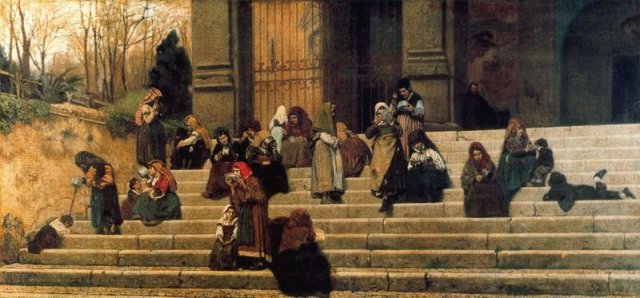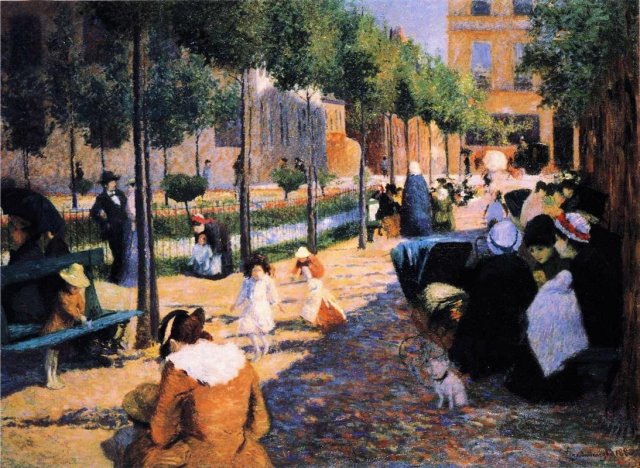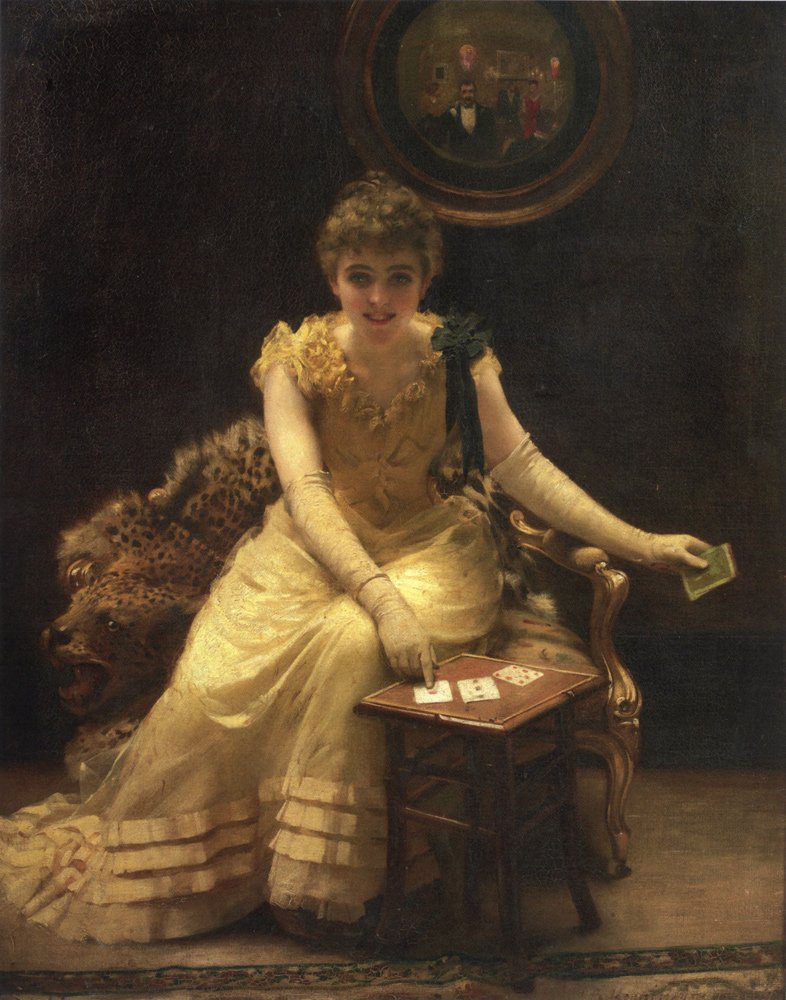
My chosen subject today is the life and works of a nineteenth century Belgian artist. He has been designated as a Symbolist painter and yet when I look at his work only some of it seems to fall into that category. Other of his paintings tend towards realism. So, in this first of two blogs about the artist, I am going to concentrate on his woks of Realism.

The artist I am looking at today is Léon-Henri-Marie Frédéric. He was one of the most prominent representatives of the Belgian symbolist school. He was born in the Brussels’ municipality of Uccle, on August 26th, 1856. His parents were Eugène Frédéric, a wealthy jeweller, and Felicie Dufour. Léon was brought up in a crowded Roman Catholic household and at the age of seven, his parents sent him to the Institute of Joséphites in Melle, a Jesuit boarding school. In 1871, at the age of fifteen, he began working as an apprentice to the painter, decorator Charles Albert, and at the same time, attended the evening classes of the Brussels Academy of Art, where he became a pupil of Jules Vankeirsblick and Ernest Slingeneyer. He also worked in the studio of Jean Portaels, the Neo-Classicist painter who at the start of 1878 became the director of the Académie Royale des Beaux-Arts de Bruxelles. In 1875, Léon joined other young painters and they rented a studio and set up a collective, pooling their money so as to employ living models.

One of the greatest of prizes on offer to young aspiring artists was to win the Prix de Rome. The original Prix de Rome was a scholarship for arts students and was created in 1663 in France under the reign of Louis XIV. The prize, organised by Académie royale de peinture et de sculpture, was open to their students. The award winner would win a stay at the Palazzo Mancini in Rome at the expense of the King of France. The Royal Academy of Fine Arts Antwerp followed suit in 1832 and organised the the Belgian Prix de Rome with a similar prize being given to the winner. Léon entered the competition on three occasions but without any success. He was devastated, so much so, that his father financed a two year-long study trip for his son in 1876. Léon travelled to Italy in the company of Juliaan Dillens, who had won the Prix de Rome for sculpture the previous year. Léon travelled extensively through Italy visiting Naples, Rome, Florence and Venice. He visited museums and observed the work of the great Italian Masters. His favourite artists were said to have been Botticelli and Domenico Ghirlandaio. He was also influenced by the Italian primitives and that of the English Pre-Raphaelites, and Burne-Jones in particular. As a painter, Léon said pain ting gave him an understanding of the overpowering beauty and harmony of nature with mankind. This sense of accord was balanced by his own artistic vision which expressed a truthfulness to nature.

On his return to Belgium in 1878, Léon joins the Brussels-based artist group known as L’Essor. The group was created in 1876, and was formed by a group of art students who had once studied at the Academy of Fine Arts in Brussels, although in 1879 this artists group severed all links it had with the Academy. The motto of the group was “a unique art, one life“, and concentrated on the relationship which they believed should unite the Art to Life. The founders of the group wanted their art to be a pictorial condemnation of the bourgeois and conservative Literary and Artistic Circles of Brussels.
In this first blog about Frédéric I am going to concentrate on his artwork which is looked upon as Naturalism and Realism. In the early days, Léon Frédéric mainly painted realistic scenes of the lives of the less well-off people such as labourers, the homeless and farm workers. He empathised with their grief and depravation but at the same time he was also very inspired by their never-ending and fervent religious beliefs of the old people who lived in these countryside areas.

He completed a set of five group portraits entitled Les Âges du paysan (The Age of the Peasant) which depict the five different stages in the life of rural peasants. Besides the aging process very little changes with their poor attire and their seemingly acceptance of what life has offered them.




Around this time Léon was inspired by the art of the French Naturalism painter Jules Bastien Lepage and Léon’s 1882 triptych painting Les marchands de craie (The Chalk Merchants) was inspired by the French painter.

The three paintings incorporate three distinct times in the day of a family of workers. The triptych was hailed as a veritable masterpiece of Realism / Naturalism and, like some of Bastien-Lepage’s work, is particularly sensitive to the plight of the poor. It was exhibited to great acclaim at the Brussels’s Salon in 1882.

The left-hand panel depicts a poor family of chalk sellers setting out for work. In the background is their small village. It is a harrowing depiction. The mother is wrapped up against the cold and yet her reddened hands are bare. Her face is half hidden by her headscarf but we still meet her penetrating stare, an almost accusing glower. On her back is a heavy basket of chalk which they hope to sell. Behind her is her husband. He has a red beard and wears a wide-brimmed, floppy hat. His eyes look tired and unable to focus. His mouth is partly open as if he is struggling to breathe. He is struggling with life both physically and mentally. He looks resigned to his fate. He carries a basket on his back which contains a very young blonde-haired child. In one hand he holds a wicker basket containing their food. His other hand clasps the hand of his dark-eyed, rosy-cheeked son, a bare-footed child, whose small dirty hand grasps a piece of bread which he is eating. They all look tired and yet the day’s work has yet to begin.

The middle panel depicts the family having a modest noontime meal as they sit in some barren fields with a small town in the background. The family from the previous picture have been joined by a woman nursing her baby and her child sitting besides her. Before them is a pot of boiled potatoes which they are eating with their bread. The two women and the children are all bare-footed. The man has taken off his hat and we see he is bald. The women in the centre once again fixes us with a questioning glower, almost as if she is demanding to know why we should be looking at them

In the right hand panel we see the family returning home after a day’s work. They all have their back to us. Their village is on the left and way in the background a city looms. The wooden basket and the wicker one they carry have been lightened of food and chalk but still it is a wearying trek back to their village. The man staggers with the weight of the young sleeping child he cradles in his arms. The mother looks down at her other child, who walks besides her, hand in hand, to see if he is alright. This was just one of Frédéric’s paintings which shows that he was aware of social inequality in Belgian society.

Another of Frédéric’s Naturalist paintings which was influenced by Bastien-Lepage was his beautiful 1888 portrayal of two children, entitled Two Walloon Farm Children. Bastien-Lepage, who was renowned in France as the leader of the evolving Naturalist school, had died after a long illness in 1884, aged just 36 and Frédéric took over the Naturalist mantle. The painting is both exquisite and yet troubling. It is a portrait of child poverty. The two sit on chairs, finger tips touching, wearing white-collared grey smocks. The plain clothes seem clean and but for their dull simplicity, do not insinuate poverty. Their hands and fingernails are dirty suggesting a peasant life which is further alluded to by their rosy cheeks brought about by their outdoor life. The two girls who look out at us seem to be displeased with our attention to their life. It is one of the most moving images of the deprivation which went hand in hand with rural life. Frédéric’s naturalist style of painting brings with it a vision of a harsh, grim lifestyle with all the hardships that poverty brings to the table. It was not the fault of the people but the unstoppable march of industrial modernity. If one look at all his paintings featuring the harsh life suffered by the peasants one does not detect or sense rebellion, just a sense of dejection and resignation and that life for them would carry on through their faith in God.

During Frédéric’s travels around Italy in 1878 it is thought that he may have visited the Umbrian town of Assisi and seen Giotto’s famed cycle of twenty-eight frescoes on the lower part of the walls of the nave and entrance in the town’s upper church of St. Francis at Assisi. In 1882 Frédéric painted a triptych depicting St. Francis, simply entitled The Legend of Saint Francis. In the left-hand panel we see the saint walking down a country path and the centre panel depicts him feeding the hens. The right-hand panel is more interesting as it recounts the tale of the St Anthony as written in the 14th century book, Fioretti di San Francesco (The Little Flowers of St. Francis) a fifty-three chapter book on the life of the Saint, one of which talks about the Wolf of Gubbio, which according to the book terrorized the Umbrian city of Gubbio until it was tamed by St. Francis of Assisi acting on behalf of God.

In 1883, Léon Frédéric left Brussles and went to live in Nafraiture, a small rural village in the Ardennes region of southern Belgium, close to the French border, where he lived for several years. Many of Frédéric’s works after his re-location depict poor people and peasants and the artist’s work focused on the harsh reality of peasant life. One of his paintings, thought to have been completed around 1886, focuses on grief and hardship and were thought to have been completed during his time at Nafraiture. The painting was entitled Burial of a Farmer. Sad burial scenes of country folk were popular ever since Courbet’s 1850 large-scale masterpiece, Burial at Ornans, which had gained Courbet great success at the 1850 Salon. Frédéric’s painting differs in that it depicts a procession of mourners at a village funeral in harsh wintry conditions somewhere in the Ardennes. At the head of the procession is the clergyman with the bible tightly grasped in his hand. Next to him are the close family mourners – the wife, rubbing tears from her eyes, her young son almost hidden behind the black clothes of his grandmother. Behind them are other family members, friends, and a smattering of local people. The black clothes of the mourners against the snow almost makes this a monochromatic depiction but there are just the odd splashes of colour, albeit muted, in the clothes of the three children at the right of the painting. Without doubt it is a very moving scene.
In my next blog about Léon Frédéric I will look at his work which compartmentalises him as a Symbolist painter.






























































































